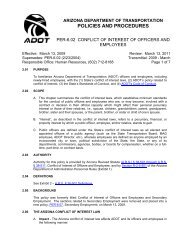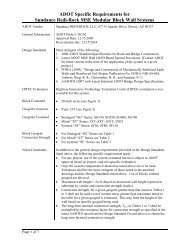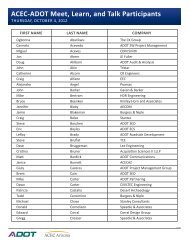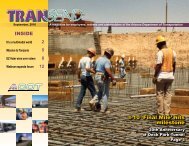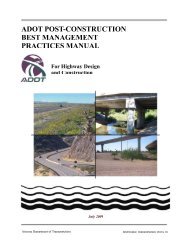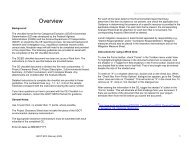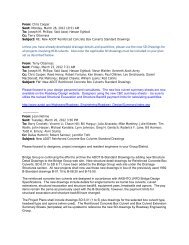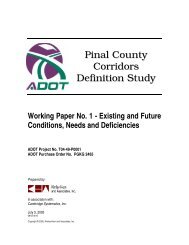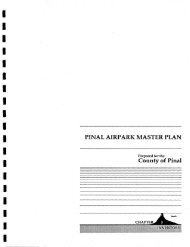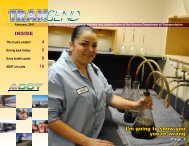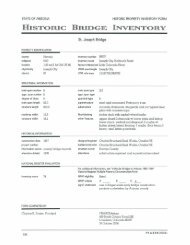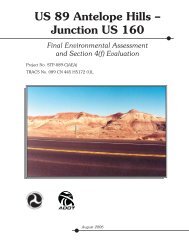I-10 Twin Peaks Traffic Interchange, Environmental Assessment
I-10 Twin Peaks Traffic Interchange, Environmental Assessment
I-10 Twin Peaks Traffic Interchange, Environmental Assessment
You also want an ePaper? Increase the reach of your titles
YUMPU automatically turns print PDFs into web optimized ePapers that Google loves.
Affected Environment and <strong>Environmental</strong> Impacts October 2005<br />
AGFD records indicate that no Gila chub surveys have been conducted within the<br />
study area; however, no native fish species have been documented within the<br />
effluent dominated reaches within the study area. Gila chub were not observed<br />
during a pedestrian survey of the study area. The study area is more than 40 miles<br />
from the nearest population of Gila chub in the Tucson Basin. Connectivity from<br />
the study area to these known populations is restricted because the Pantano and<br />
Rillito River systems no longer have perennial flows and are dry washes with the<br />
exception of flows during storm events.<br />
Gila Topminnow<br />
The Gila topminnow is listed as endangered without critical habitat. The basic<br />
habitat requirement for the Gila topminnow is water that is permanent and free<br />
from nonindigenous and invasive predators. Beyond that, habitat requirements of<br />
Gila topminnows are broad. The species historically occupied headwater springs<br />
and vegetated margins and backwater areas of intermittent and perennial streams<br />
and rivers. Topminnows can withstand water temperatures from near freezing to<br />
90-<strong>10</strong>0 degrees Fahrenheit. Gila topminnows can live in a fairly wide range of<br />
water chemistry conditions, from acidic water to water with low levels of<br />
dissolved oxygen. Preferred habitats contain dense mats of algae and debris,<br />
usually along stream margins or below riffles, with sandy substrates sometimes<br />
covered with organic muds and debris.<br />
AGFD records indicate that no Gila topminnow surveys have been conducted<br />
within the study area; however, no native fish species have been documented<br />
within the effluent dominated reaches within the study area. Gila topminnows<br />
were not observed during a pedestrian survey of the study area. The study area is<br />
more than 40 miles from the nearest population of Gila topminnow in the Tucson<br />
Basin. These drainages are not connected to the study area by perennial water<br />
flows.<br />
Southwestern Willow Flycatcher<br />
The southwestern willow flycatcher is listed endangered with proposed critical<br />
habitat. The southwestern willow flycatcher breeds in dense riparian habitats along<br />
rivers, streams, or other wetlands. The vegetation can be dominated by dense<br />
growths of willows, seep willow, or other shrubs and medium-sized trees. There<br />
may be an overstory of cottonwood, tamarisk, or other large trees, but this is not<br />
always the case. In some areas, the flycatcher will nest in habitats dominated by<br />
tamarisk and Russian olive. One of the most important characteristics of the<br />
habitat appears to be the presence of dense vegetation, usually throughout all<br />
vegetation layers present. Almost all southwestern willow flycatcher breeding<br />
habitats are within close proximity (less than 20 yards) of water or very saturated<br />
soil. This water may be in the form of large rivers, smaller streams, springs, or<br />
marshes. At some sites, surface water is present early in the nesting season, but<br />
gradually dries up as the season progresses. Ultimately, the breeding site must<br />
have a water table high enough to support riparian vegetation<br />
Interstate <strong>10</strong> <strong>Traffic</strong> <strong>Interchange</strong> at<br />
<strong>Twin</strong> <strong>Peaks</strong>/Linda Vista<br />
4-29<br />
Project No.: NH-0<strong>10</strong>-D (AIW)<br />
TRACS No.: <strong>10</strong> PM 236 H5838 01D



